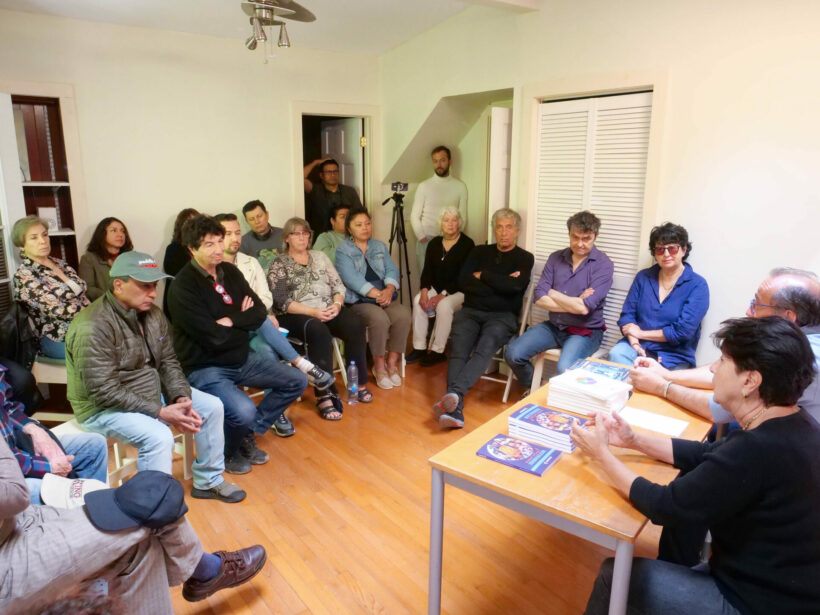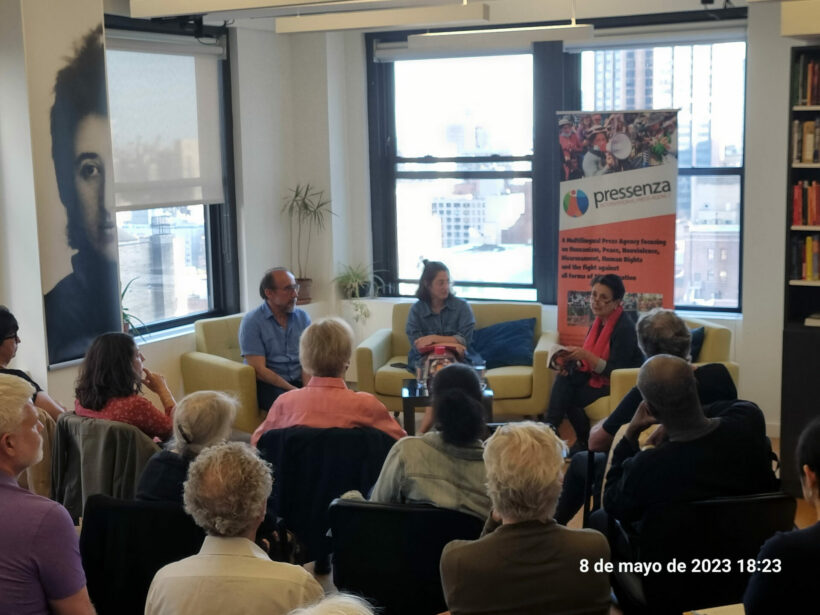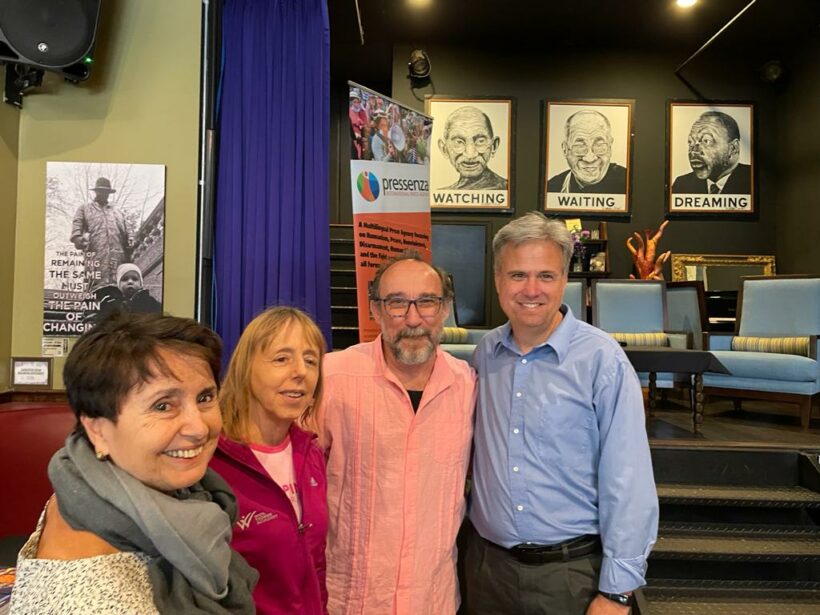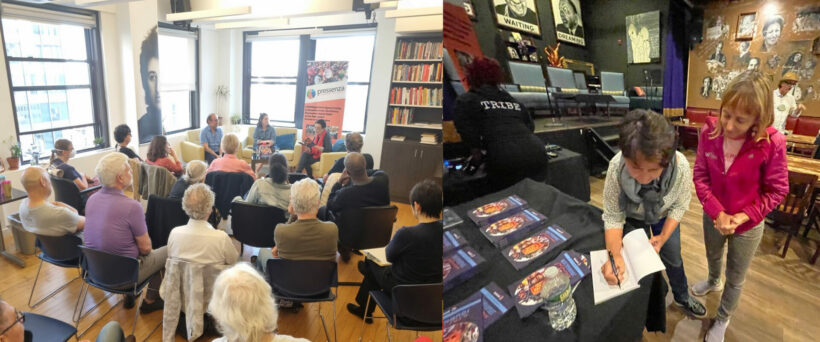During the last few days, Pressenza presented its new book on Nonviolent Journalism in the United States.
This book aims to reflect the first twelve years of collective effort run by volunteers from the fields of journalism and communication.
Talk World Radio: Why We Need Nonviolent Journalism
Talk-show with Pía Figueroa and Tony Robinson interviewed by David Swanson
The 1st event was held on May 6 during the Opening of the Hudson Valley Park of Study and Reflection
 David Andersson and Pía Figueroa – Photo by Javier Javier Castaño
David Andersson and Pía Figueroa – Photo by Javier Javier Castaño
 Photo by Jean Marc Grambert
Photo by Jean Marc Grambert
The 2nd event was held on Monday, May 8 at At Rosa Luxemburg Stiftung NY Office
 David Andersson, Mariana Fernandez and Pía Figueroa – Photo by Roberto Blueh
David Andersson, Mariana Fernandez and Pía Figueroa – Photo by Roberto Blueh
The 3rd presentation was held by World Beyond War at Busboys & Poets in Washington D.C. on Tuesday, May 9
 Pía Figueroa, Medea Benjamin, David Andersson and David Swanson – Photo by Yolanda Andersson
Pía Figueroa, Medea Benjamin, David Andersson and David Swanson – Photo by Yolanda Andersson
Talk by Fernando Garcia
Dear Friends,
It is an honor to be here today to present to you this remarkable book on journalism and nonviolence, edited by Pressenza.
I believe the importance of this book cannot be overstated, as it offers a fresh perspective on the role that can play the media in promoting peace and social justice. I want to express my gratitude to Pressenza’s director, Pia Figueroa, and the organizer of this event, David Anderson, for giving me the opportunity to speak to you today.
As a journalism professor myself, I can attest to the importance of this genre of books for future generations of journalists.
The field of journalism is facing unprecedented challenges in the digital age, including the proliferation of fake news, disinformation, and propaganda. It is more important than ever for journalists to be guided by principles, tools, perspectives and a commitment to nonviolence, democracy and social justice.
In this sense, I consider that this book could be a valuable resource for journalism students, as it offers a comprehensive and insightful approach of the relationship between journalism, nonviolence, and social change. The editors have brought together a diverse group of authors who offer different perspectives and experiences on these topics, through articles from different contributors of the News Agency Pressenza.
The book aims to facilitate the practice and understanding of nonviolence in journalism through a series of chapters. These chapters cover: a) an understanding of a humanizing vision of communication, b) a proposal of principles of nonviolent journalism, c) tools to specify this practice, d) the importance of a non-violence approach and of e) methodological clues that are oriented to facilitate teachings of this type of particular practice of journalism. Then, this book is not only aimed at those who want to dedicate themselves to the practice of ethical and critical journalism with a social sense, but also for those who consider it an ethical obligation to teach it, making it a complete book on the topic.
In this sense the contributions are not only thought-provoking but most of all, practical. As suggested, they provide guidance for journalists on how to report on issues related to conflict, violence, or social justice in a way that promotes nonviolence and empathy, but also highlights the importance of media literacy and responsible journalism in a time of information overload.
Let me insist: The importance of truth in journalism cannot be overstated. In a world where fake news, corruption, populism, bigotry, and economic, religious, and racial violence are all too prevalent, it is crucial that journalists hold themselves to a high standard of accuracy, honesty, and integrity. “Truth must be the supreme value of communication.” This means that journalists must be diligent in their pursuit of the truth, even when it is difficult or unpopular. They must be willing to ask tough questions, to investigate deeply, and to report honestly, even when it challenges the prevailing narrative or undermines the interests of those in power. In doing so, journalists can play a critical role in exposing corruption, challenging false narratives, and holding the powerful accountable. By reporting on diverse perspectives and experiences, as this book and the articles of Pressenza, journalists can help to bridge divides and promote greater understanding and compassion. They can help to counteract the forces of polarization, hatred, and violence that too often threaten to tear our societies apart. Ultimately, the pursuit of truth in journalism is not just a professional obligation, but a moral imperative. It is essential for building a more just, peaceful, and equitable world.
As the world continues to grapple with issues such as poverty, inequality, and climate change, it is clear that we need new solutions and new ways of thinking. This book offers a powerful vision of how nonviolence and compassion can be used as tools for social change. It shows us that we can be agents of change in our own communities and beyond, and that we can make a difference in the world.
One of the captains of Non Violence, Lev Tolstoy once wrote, “Everyone thinks of changing the world, but no one thinks of changing himself.” This book invites us to reflect on our own role as media consumers and producers. It challenges us to rethink the way we consume and produce news, and to strive for a more peaceful and just world.
In conclusion, I urge journalism students and professionals alike to read and have an open approach to this book now published in English thanks to Pressenza. I hope that this book may inspire new generations of journalists who are committed to nonviolent communication and social change.
In closing, I want to thank the editors and contributors of this book, for their hard work and dedication. I also want to thank Pressenza for its commitment to promoting nonviolence and social justice through its example and articles. This book is a testament to the power of collaboration and the importance of working together towards a common goal. Let us all be inspired by let us all work together to create a more peaceful and just world. Thank you.
May 9 Video by David Swanson






